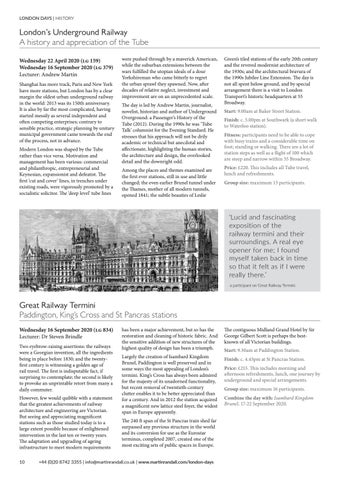LONDON DAYS | HISTORY
London’s Underground Railway A history and appreciation of the Tube Wednesday 22 April 2020 (lg 159) Wednesday 16 September 2020 (lg 379) Lecturer: Andrew Martin Shanghai has more track, Paris and New York have more stations, but London has by a clear margin the oldest urban underground railway in the world: 2013 was its 150th anniversary. It is also by far the most complicated, having started messily as several independent and often competing enterprises; contrary to sensible practice, strategic planning by unitary municipal government came towards the end of the process, not in advance. Modern London was shaped by the Tube rather than vice versa. Motivation and management has been various: commercial and philanthropic, entrepreneurial and Keynesian, expansionist and defeatist. The first ‘cut and cover’ lines, in trenches under existing roads, were vigorously promoted by a socialistic solicitor. The ‘deep level’ tube lines
were pushed through by a maverick American, while the suburban extensions between the wars fulfilled the utopian ideals of a dour Yorkshireman who came bitterly to regret the urban sprawl they spawned. Now, after decades of relative neglect, investment and improvement are on an unprecedented scale. The day is led by Andrew Martin, journalist, novelist, historian and author of Underground Overground: a Passenger’s History of the Tube (2012). During the 1990s he was ‘Tube Talk’ columnist for the Evening Standard. He stresses that his approach will not be drily academic or technical but anecdotal and affectionate, highlighting the human stories, the architecture and design, the overlooked detail and the downright odd. Among the places and themes examined are the first ever stations, still in use and little changed; the even earlier Brunel tunnel under the Thames, mother of all modern tunnels, opened 1841; the subtle beauties of Leslie
Green’s tiled stations of the early 20th century and the revered modernist architecture of the 1930s; and the architectural bravura of the 1990s Jubilee Line Extension. The day is not all spent below ground, and by special arrangement there is a visit to London Transport’s historic headquarters at 55 Broadway. Start: 9.00am at Baker Street Station. Finish: c. 5.00pm at Southwark (a short walk to Waterloo station). Fitness: participants need to be able to cope with busy trains and a considerable time on foot; standing or walking. There are a lot of station steps as well as a flight of 100 which are steep and narrow within 55 Broadway. Price: £220. This includes all Tube travel, lunch and refreshments. Group size: maximum 15 participants.
‘Lucid and fascinating exposition of the railway termini and their surroundings. A real eye opener for me; I found myself taken back in time so that it felt as if I were really there.’ a participant on Great Railway Termini.
Great Railway Termini Paddington, King’s Cross and St Pancras stations Wednesday 16 September 2020 (lg 834) Lecturer: Dr Steven Brindle Two eyebrow-raising assertions: the railways were a Georgian invention, all the ingredients being in place before 1830; and the twentyfirst century is witnessing a golden age of rail travel. The first is indisputable fact, if surprising to contemplate; the second is likely to provoke an unprintable retort from many a daily commuter. However, few would quibble with a statement that the greatest achievements of railway architecture and engineering are Victorian. But seeing and appreciating magnificent stations such as those studied today is to a large extent possible because of enlightened intervention in the last ten or twenty years. The adaptation and upgrading of ageing infrastructure to meet modern requirements 10
has been a major achievement, but so has the restoration and cleaning of historic fabric. And the sensitive addition of new structures of the highest quality of design has been a triumph.
The contiguous Midland Grand Hotel by Sir George Gilbert Scott is perhaps the bestknown of all Victorian buildings.
Largely the creation of Isambard Kingdom Brunel, Paddington is well preserved and in some ways the most appealing of London’s termini. King’s Cross has always been admired for the majesty of its unadorned functionality, but recent removal of twentieth-century clutter enables it to be better appreciated than for a century. And in 2012 the station acquired a magnificent new lattice steel foyer, the widest span in Europe apparently.
Finish: c. 4.45pm at St Pancras Station.
The 240 ft span of the St Pancras train shed far surpassed any previous structure in the world and its conversion for use as the Eurostar terminus, completed 2007, created one of the most exciting sets of public spaces in Europe.
+44 (0)20 8742 3355 | info@martinrandall.co.uk | www.martinrandall.com/london-days
Start: 9.30am at Paddington Station. Price: £215. This includes morning and afternoon refreshments, lunch, one journey by underground and special arrangements. Group size: maximum 16 participants. Combine the day with: Isambard Kingdom Brunel, 17-22 September 2020.
